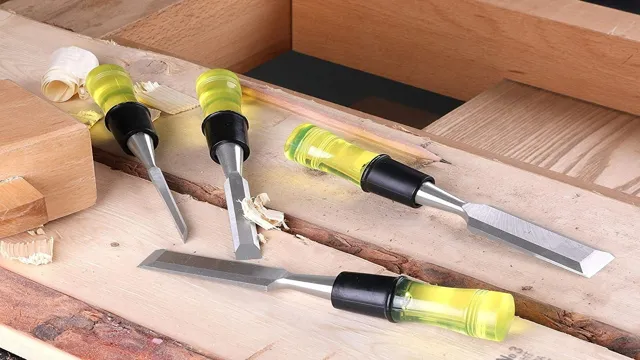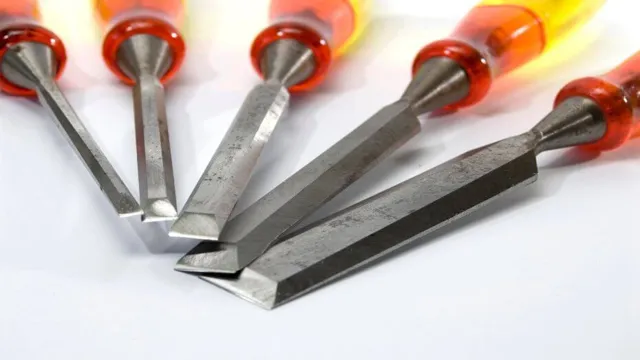Have you ever wondered if you can use regular chisels on a lathe? The short answer is yes, you can! Using regular chisels on a lathe is a simple way to create intricate designs and shapes in your woodturning projects. However, there are a few things you need to know before getting started. When using regular chisels on a lathe, it’s important to have a good understanding of the different types of chisels available and their specific uses.
One of the most important things to consider is the angle of the chisel. Chisels designed for use on a lathe typically have a steeper angle than those used for hand carving. This allows for more precise cuts and a smoother finish.
Another important factor is the sharpness of your chisels. Using dull or improperly sharpened chisels can result in a rough finish and make it difficult to work with the wood. Properly sharpening your chisels is crucial for achieving a smooth, clean cut.
Overall, using regular chisels on a lathe can be a great way to add depth and texture to your woodturning projects. With a little practice and knowledge, you can create beautiful and intricate designs that will make your work stand out. So why not give it a try? Your next masterpiece could be just a few chisels away.
Can Regular Chisels be Used on a Lathe?
As an amateur woodworker, you might be wondering if your regular chisels can be used on a lathe for woodworking. The answer is yes, but with certain limitations. Regular chisels, also known as bench chisels, are designed for precise handwork rather than machine-turned surfaces.
However, with some modifications, they can be used with a lathe to produce outstanding results. You’ll need to sharpen your chisels to create a long and narrow cutting edge tuned to the lathe’s speed. You’ll also want to make sure that you’re using high-speed steel chisels, as they’ll be able to withstand the heat generated by the lathe’s high-speed rotation.
Additionally, investing in carbide-tipped chisels can also prove to be useful, providing more longevity and precision. Despite some modifications, regular chisels can be a good starting point for beginners while they hone their skills. So, experiment with your regular chisels, but be cautious and make sure you’re taking the necessary precautions to achieve the best results.
Understanding Lathe Chisels
Lathe chisels are specially designed tools that are meant to be used on a lathe. These tools have a specific shape that allows them to cut through wood with ease, while also reducing the risk of kickback. Regular chisels, on the other hand, are not designed for use on a lathe.
While it may be tempting to use a regular chisel if you don’t have a lathe chisel, it’s important to understand that doing so can be dangerous. Regular chisels are not designed to handle the high-speed rotation of a lathe, and they can easily become damaged or cause serious injury. If you’re planning to work with a lathe, it’s crucial to invest in a set of lathe chisels.
With the right tools, you’ll be able to create precise cuts and beautiful finishes on your woodwork.

Types of Chisels Used on a Lathe
When it comes to woodworking on a lathe, one of the most essential tools needed is a chisel. But what types of chisels can be used? While regular chisels can be used, they are not recommended as they are designed for use on flat surfaces. Instead, specialized chisels designed for use on a lathe should be used.
These chisels come in a variety of shapes and sizes, including gouges, scrapers, and parting tools. The type of chisel used depends on the particular project and the desired outcome. Gouges are used primarily for shaping and roughing out a workpiece while scrapers are used for smoothing and finishing.
Parting tools are used for cutting off a finished piece from the lathe. Using the correct type of chisel for the job at hand will ensure clean cuts and a professional finish.
Pros and Cons of Using Regular Chisels on a Lathe
Many woodworkers wonder whether regular chisels can be used on a lathe. While it is possible to use regular chisels, there are some pros and cons to consider. One advantage is that regular chisels are more versatile than specialized lathe tools; they can handle a wide variety of shapes and sizes and can be used to achieve unique designs.
However, regular chisels require a different technique and amount of pressure than lathe tools for accurate and safe use, which can take time to master. Additionally, regular chisels can cause more vibration and chatter than lathe tools, which can produce uneven surfaces and reduce the quality of the final product. Overall, using regular chisels on a lathe may be suitable for experienced and skilled woodworkers, but it may not be the best choice for beginners or those who prioritize precision and smoothness in their work.
Advantages of Using Regular Chisels on a Lathe
Lathe chisels are an essential tool for woodworking enthusiasts. However, using regular chisels on a lathe can have its advantages over specialized tools. The main benefit is cost-effectiveness as regular chisels are low-priced compared to their specialized counterparts.
Moreover, regular chisels allow more versatility and control during turning. They can also be sharpened to your desired edge without requiring a specialized sharpening tool. However, it is noteworthy that using regular chisels requires experience and familiarity with the tools to avoid accidents.
In summary, while using regular chisels on a lathe has its advantages, it is imperative to exercise caution and take safety precautions to prevent unwanted mishaps.
Disadvantages of Using Regular Chisels on a Lathe
While it is possible to use regular chisels on a lathe to shape wood, it comes with several disadvantages. Firstly, regular chisels are not designed for use on a lathe, and thus they may not be able to handle the speed or force required for turning wood. This can lead to the chisels breaking or becoming damaged, which can also pose a safety hazard to the user.
Additionally, regular chisels may produce less accurate cuts and finishes compared to specially designed lathe chisels, which can impact the overall quality of the finished product. Overall, while regular chisels may seem like a convenient option for lathe work, it is best to use chisels specifically designed for lathe work to ensure the safety of the user and the quality of the final product.
Tips for Using Regular Chisels on a Lathe
“Can you use regular chisels on a lathe?” Absolutely! In fact, using regular woodworking chisels on a lathe is a common practice among many woodturners. However, there are a few things to keep in mind when doing so. First, make sure that the handle of the chisel is comfortable and ergonomic enough for turning.
Also, be sure to keep the chisel sharp to prevent any dangerous kickback or catches. Additionally, keep in mind that using regular chisels on a lathe may not provide the same precision and control as specialized turning tools. With that said, if you’re just starting out or working on a budget, using regular chisels on a lathe is a great option to not only save money but also challenge yourself creatively.
Choosing the Right Chisel for the Job
When it comes to using chisels on a lathe, it’s important to choose the right one for the job. Regular chisels can be used on a lathe, but there are a few things you should keep in mind. First off, make sure the chisel is sharp and in good condition before you start.
You don’t want to be struggling with a dull blade while you’re trying to work. Second, consider the shape and size of the chisel. Different shapes will be better suited for different tasks, so make sure you have the right one for the job.
Lastly, be sure to use the chisel properly and safely. Keep your fingers away from the blade, and always use the tool rest to support the chisel while you’re working. With these tips in mind, you can use regular chisels on a lathe with confidence and precision.
Sharpening Regular Chisels for Lathe Work
Sharpening regular chisels for lathe work can be a simple task if you know a few tips and tricks. First and foremost, it’s crucial to ensure that the chisel is sharp enough to make clean and precise cuts. You can use a honing stone or sandpaper to sharpen the blade.
When using sandpaper, start with 200 grit and gradually move to finer grits. Another essential aspect is to ensure that the chisel is positioned at the correct angle to the workpiece. The angle will depend on the type of cut you want to make.
For instance, if you want to make a roughing cut, you’ll need a steeper angle than for a finishing cut. When working with regular chisels, always remember to use light pressure and let the tool do the work. You can also use a roughing gouge or scraper to remove excess material before making the final cut.
By following these tips, you can use regular chisels effectively and produce excellent results on your lathe projects.
Conclusion
In the end, it’s like trying to use a screwdriver to hammer in a nail – sure, you might get the job done, but it won’t be pretty and it won’t be efficient. So while you technically could use regular chisels on a lathe, it’s not recommended. Invest in a set of lathe chisels and save yourself from frustration and potential accidents.
Your lathe (and your sanity) will thank you!”
FAQs
What are the different types of chisels that can be used on a lathe?
There are specialized chisels, such as spindle gouges and bowl gouges, that are designed specifically for use on a lathe. However, with the right technique and sharpness, regular bench chisels can also be used.
Can regular bench chisels cause damage to a lathe?
Yes, if they are not used properly or are dull, regular bench chisels can cause damage to a lathe. It is important to follow proper technique and keep the chisels sharp to avoid any potential damage.
How do I sharpen chisels for use on a lathe?
Chisels for use on a lathe should be sharpened at a steeper angle than regular bench chisels, typically around 60 degrees. A sharpening jig can be used to maintain consistency in the angle. It is also important to use a sharpening stone with a grit of at least 1000.
What are the safety precautions when using chisels on a lathe?
Always wear eye protection when using a lathe. It is also important to keep the tool rest close to the workpiece and to use two hands for stability.
How do I know which chisel to use for a specific turning project?
A spindle gouge is best for making delicate curves and details, while a bowl gouge is better for removing larger amounts of material. It is important to choose the right chisel for the job to achieve the desired result.
Can I use a carving chisel on a lathe?
No, carving chisels are not designed for use on a lathe and can be dangerous if used improperly. Stick to specialized lathe chisels for turning projects.
What is the difference between high-speed steel and carbon steel lathe chisels?
High-speed steel is a harder material that holds an edge longer, making it ideal for frequent use. Carbon steel is a softer material that requires more frequent sharpening, but is more affordable and easier to sharpen at home. The choice ultimately depends on personal preference and frequency of use.





